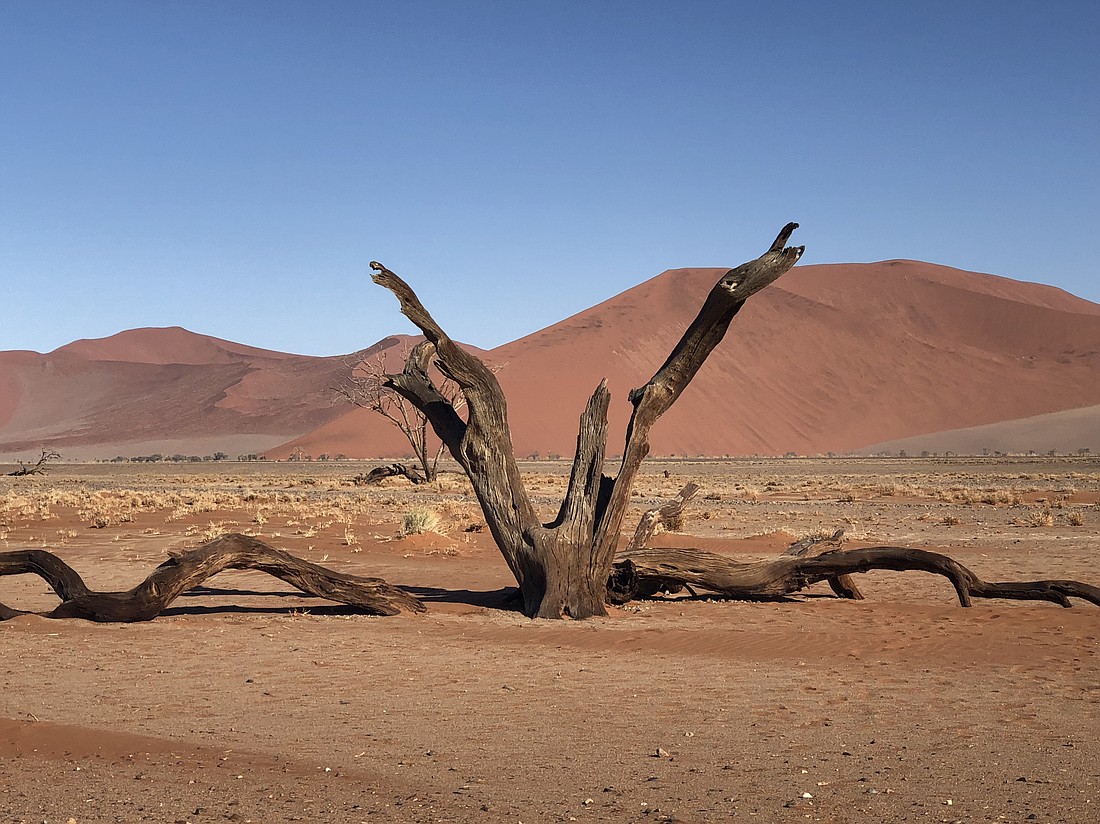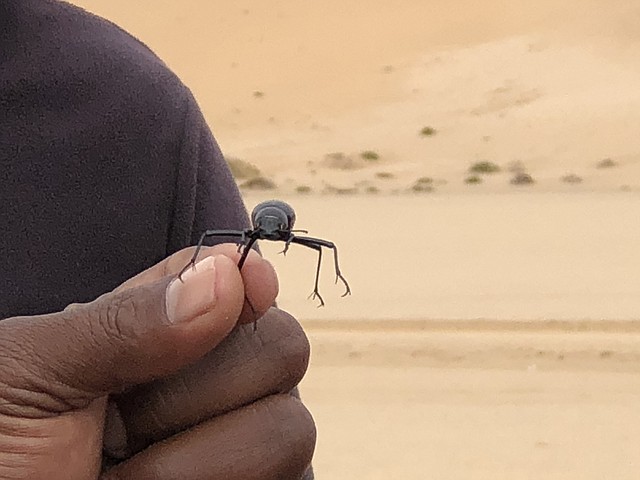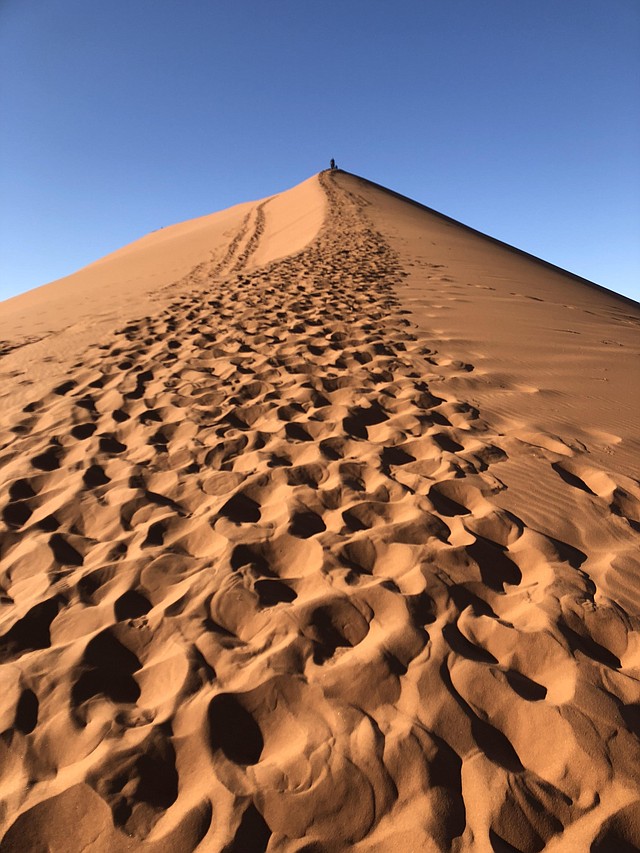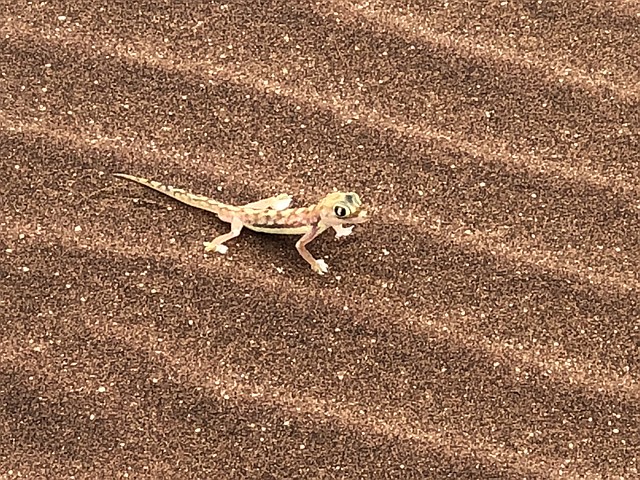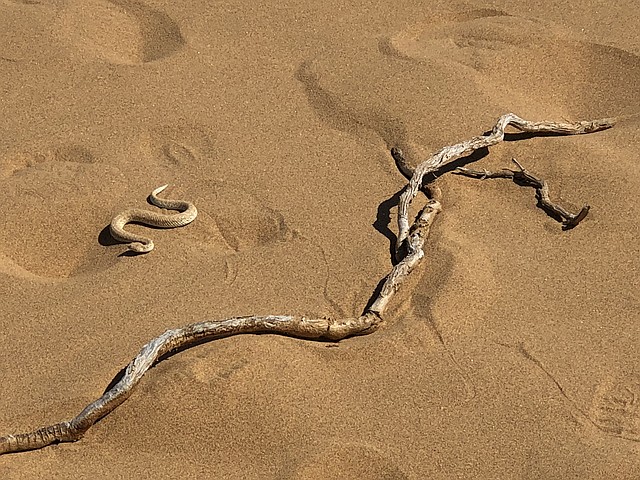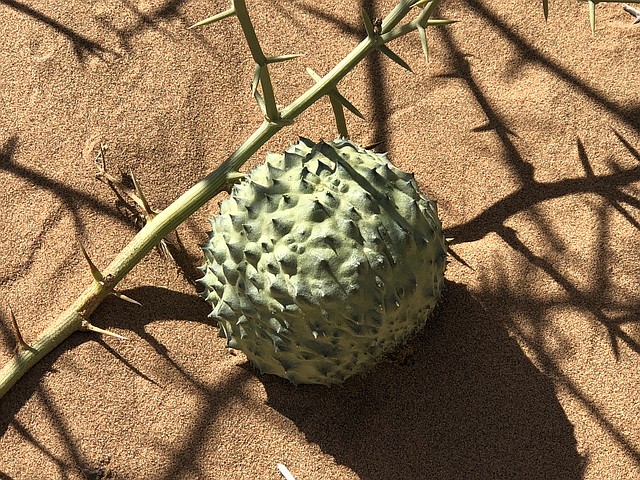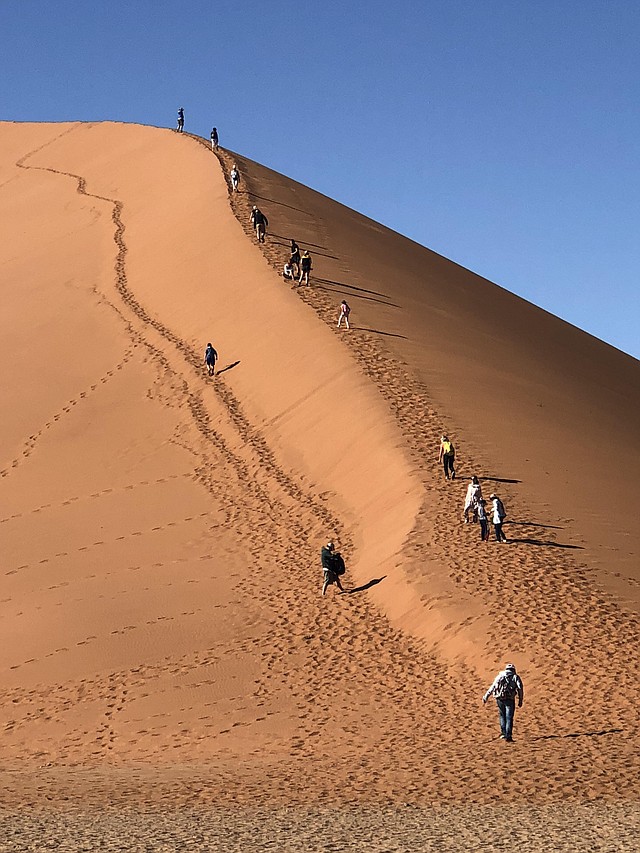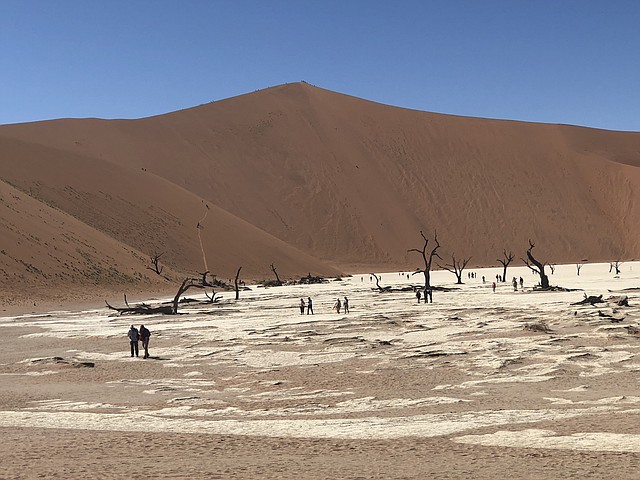Hot on the trail of Namibia's Little Five
April 1, 2019 at 6:00 a.m.
Everyone touts the Big Five in Africa –the lion, leopard, rhino, elephant and buffalo. They’re the photogenic celebrities of the savannah that travelers yearn to see on safari. And as each is sighted, you can almost hear the sound of a checkmark being made on the proverbial bucket list. But, there’s another group of creatures who fly way below the radar, yet deserve attention for their own star-studded qualities.
The Little Five of the Namib Desert consists of the lizard, snake, gecko, chameleon and spider. These creatures live in the world’s oldest desert, covering an area of around 31,000 square miles. It’s an arid place, receiving as little as a half an inch of rainfall a year with temps that reach up to 113 degrees Fahrenheit. For anything to survive in these extreme conditions, it would need to have cleverly adapted over the millennia.
The Little Five are difficult to find due to their size and most people are oblivious to their presence. You have to know how to track the tiniest of wildlife and follow subtle clues within the environment. Or, you need to be in the company of a well-trained guide, who can facilitate the discovery process.
Being unskilled in this detective-like endeavor, I opted to join a Living Desert Safari with Batis Birding Company. The tour, which departed from the coastal resort of Saukopmund, promised an up close and personal experience with desert life along the eastern part of Namibia’s major sand dune belt within Dorab National Park. The country’s grand dunes are world famous and a definite highlight for visitors, who enjoy climbing them for the stellar views they provide of the starkly beautiful Namib Desert…and, of course, for the bragging rights they gain from their accomplishments!
These dramatic natural wonders were created by sand carried via the wind off the coast of Namibia. They developed over millions of years and are characterized by their striking brick red and burnt orange colors. This vivid hue is due to their iron oxide content. As the lighting shifts during the course of the day, so does the appearance of the dunes’ tones, making them a fascinating subject for photographers. It’s a dynamic landscape that’s ever-changing and there is no rest from the relentless movement of sand in this place of space and silence.
The name Namib comes from the local Nama language and roughly translates to “an area where there is nothing.” As far as wildlife is concerned, however, this couldn’t be further from the truth. What appears to be a sandy, barren wasteland, is actually home to a host of creatures that crawl, hop and slither across the “dune sea.”
The first of the Little Five that we got to see on tour was the Palmato Gecko, a colorful nocturnal nomad, who spends most of the day burrowed under the sand. It uses its webfeet to dig holes for its home. These special feet, which also have adhesive pads, allow it to run at great speeds and to ascend the dunes with ease. The gecko’s translucent skin provides excellent camouflage against predators and its large lidless eyes are ideal for spotting prey. The eyeballs capture moisture, too, which the gecko licks off with its tongue to drink. Our guide dug until he found one of these fascinating creatures and when uncovered, it immediately froze in defensive mode. After we had a chance to examine the gecko from every angle possible, the guide carefully replaced it in the hole, where it disappeared in a flash.
The tour revealed another sand dweller, the Fitzsimmons Burrowing Skink. These slithery lizards typically forage later in the day when the sand is of a more suitable temperature. As they move, they leave characteristic wavy tracks. Our guide had eagle eyes because he saw the skink’s signs from within the vehicle. He braked hard, jumped out, ran partway up a dune, shoved his arm into the sand and then triumphantly held it up to us, holding what initially appeared to be a tiny snake.
We continued our treasure hunt and came across a Shovel-snouted lizard. This is the famous “dancing lizard” of the Namib Desert. To avoid overheating in the scorched sand, it raises alternating feet every ten seconds in a well-coordinated routine. When this strategy no longer works (or if it needs to escape danger), the lizard dives down into the sand seeking cooler temps. Its snout helps it to plunge deeply and “swim,” where it can remain buried for up to twenty-four hours, using air trapped in the sand. Our guide explained that this type of lizard is one of the fastest creatures in the desert and that its impressive hind legs can propel it forward with force. The speed allows it to capture its prey, which not only provides food, but also water. If unsuccessful in its hunt, the lizard is fortunate to have a second bladder for storing moisture from the desert fog.
We also spotted a Cartwheeling spider. Unlike others of its species that typically spin a web as an entrapment device, the Cartwheeling spider roams around searching for prey. This is a dangerous pursuit, however, as it makes them a target for hungry wasps looking to implant their larvae in the spider. They feed off the spider and eventually kill it. To avoid such a nasty fate, this creature has adapted an unusual getaway plan. It cartwheels down the dunes at forty-four turns per second in a blur of motion. If there were insect Olympics, the Cartwheeling spider would undoubtedly win a gold medal.
The Sidewinder was a highlight for many on the tour. This venomous viper was well-camouflaged in the sand when our guide first found him. Its body was completely hidden with the exception of its eyes, which peeped out from atop its head. What’s exceptional about these creatures is the way they move – spiraling on their sides in smooth lateral curves. We watched in awe as the snake gracefully undulated up the steep dunes. It kept most of its body off the sand, allowing it to travel over the hot surface without overheating. As an ambush hunter, the Sidewinder remains still, then wiggles its tail to attract its prey.
My favorite of the Five was the Namaqua chameleon. This is the fastest chameleon in the world. It uses its lightening quick speed to race after skittering beetles and can eat up to two hundred of these insects a day. And it changes color to regulate its temperature, turning darker in the morning to absorb warmth, then lightening in the heat of the day to reflect the sun’s rays.
There were other creatures we found during the tour, such as a Horned Adder hiding in the shade of a small scrub. It hissed and our guide instructed us to keep our distance. He explained that although this snake’s venom is mild, it will still cause swelling and pain. We managed, albeit cautiously, to get close enough to see the distinctive raised horny scales above each of the adder’s eyes.
As for birds, we spotted several Tractrac Chats. Prolific in the Namib Desert, these birds are aptly named for their odd song – a series of discordant and jarring chucks and gurgles. They typically are seen in pairs, as they mate for life.
Our guide also provided us with information about the geology and geography of the Namib Desert and pointed out various plants that are able to survive in this environment. The Dollar bush, for example, is endemic to the area. It’s a succulent with characteristically round leaves, which many say resemble coins. The Nara bush has the distinction of being one of the most useful plants for both animals and humans. It’s eaten by giraffes, rhinos, jackals and beetles, among other creatures. People will boil the melon ball, which releases seeds from the pulp. The seeds are then baked in the sun and eaten like nuts, while the pulp when dried, can be made into flat cakes and stored for later consumption. The melon ball also makes a convenient water bottle and food source in one.
From a medical standpoint, the Nara bush has much value. The fresh pulp is said to relieve stomach aches and cure internal diseases. And if you crush the roots and mix them with an oil, you can apply the substance to wounds in order to hasten healing. The roots are equally known for their ability to cleanse the body and build up the immune system.
In addition to desert wildlife tours, visitors to Namibia’s dunes have a number of other activity options. If you’re an adrenaline junkie, you can go sand boarding, skydiving, hop on a dune buggy or ride a quad bike. Or, you can take a scenic flight for a bird’s eye view of the Namib Desert.
Some of the more spectacular dunes of Namibia are around Sossusvlei, an area distinguished by a large salt and clay pan, denoting the end of the Tsauchab River’s course. The word Sossusvlei literally translates to “dead-end” (from the Nama word “Sossus”) “marsh” (from the Afrikaans word “Vlei”). This well-known expanse is a perfect specimen of Namibia’s unspoiled desert beauty and is synonymous with images of the country.
If you want to climb one of the dunes, start with Dune 45. With its fascinating shape and accessibility, this is one of the most photographed dunes in the world. The 262-foot climb is well worth the effort, as you’ll be rewarded with an incredible panorama of Dune Valley.
For more of a challenge, tackle Big Daddy, the highest dune in Sossusvlei, though not the highest in the Namib Desert. This honor is given to Dune 7, which has been measured at 1,066 feet tall. The climb up Big Daddy is not for the faint-hearted or anyone with a fear of heights. You need to start early in the morning due to the heat, but also because that’s the time when the place is most picturesque. The rising sun makes one side of this monstrous dune glow a fiery red, while the other is entirely in the shadows. When you reach the first plateau, you’ll get a peek down into Dead Vlei, the white pan filled with the skeletons of age-old camelthorn trees.
Ascending the second peak requires stamina and an extremely large bottle of water. By this time, the sun is blazing and there’s not a spot of shade in sight. But, when you reach the summit, the scene is astounding. Pinch yourself! You’ve just conquered one of nature’s toughest goliaths. And you can take comfort in knowing that the descent is a piece of cake. Just slide down the side and in mere minutes, you’ll be on the parched clay of Dead Vlei. Toast to your accomplishment with an ice-cold Windhoek Lager.
If you go:
http://www.namibiatourism.com.na/
Debbie Stone is an established travel writer and columnist, who crosses the globe in search of unique destinations and experiences to share with her readers and listeners. She’s an avid explorer who welcomes new opportunities to increase awareness and enthusiasm for places, culture, food, history, nature, outdoor adventure, wellness and more. Her travels have taken her to nearly 100 countries spanning all seven continents, and her stories appear in numerous print and digital publications.
